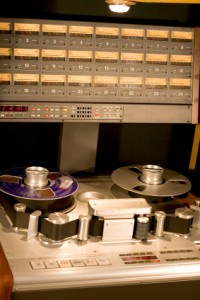 When someone says “pro audio tools” what they really mean is equipment that is used at a professional level to create and/or produce top-notch audio recordings. That prefix pro conjures up images of high-end recording gear such as microphones costing thousands of dollars, gleaming mic preamplifiers and other outboard devices seen in big commercial recording studios. I would like to humbly challenge that automatic assumption and attempt to separate the word professional with the term expensive.
When someone says “pro audio tools” what they really mean is equipment that is used at a professional level to create and/or produce top-notch audio recordings. That prefix pro conjures up images of high-end recording gear such as microphones costing thousands of dollars, gleaming mic preamplifiers and other outboard devices seen in big commercial recording studios. I would like to humbly challenge that automatic assumption and attempt to separate the word professional with the term expensive.
It is true that for most of the past several decades, the best audio recording quality was only realistically obtained through the use of expensive equipment. There were several reasons for this, but mostly it was down to the fact that in order to reproduce a sound anywhere near accurately, you had to use big, fast magnetic tape. By big, I mean wide; like one or two inches wide. And by fast I mean spinning on a machine much faster than consumer reel-to-reel tape machines could usually handle, like 30 inches per second. Cassette machines only got to a max of 3-3/4 inches per second. This was necessary because it took lots of tape particles to be magnetized and aligned to sound really good; or to sound a lot like the original (the word “fidelity” was used a lot for this). So first, you had to have a wider stripe than consumer tapes had, and then you had to have it hurtling past the head on the tape recorder to maximize how many tape particles could be realigned per second.
Tape recorders that could record multiple tracks (4-, 8-, 16-, 24-, or 32-track) at once, recording fast on wide tape were expensive. Mostly only commercial studios owned them. In addition to the recorder and the tape, you needed a mixing board, microphones, amplifiers, and effect racks for things like equalization, compression, reverb, etc. By the time you tot the price for even a modest studio using that kind of gear, you’re easily talking many thousands of dollars, not to mention the space you needed to put the stuff down.
But now we live in the 21st century, where we can use our ubiquitous computers to be both tape machine AND tape. Digital audio makes it so we can reproduce audio to a very high fidelity quickly, inexpensively, and without having to buy much more than you could fit in your hand. Let that be the reason you separate the concept of professional from the idea of money. Today, if you already have a computer with an internet connection, you can put together a home recording studio capable of recording and producing professional quality sound for as little as $50, which is about the price of a decent USB microphone, such as the Samson Q1. With just that microphone, and a copy of the free audio software called Audacity, you’ll be on your way. Then as you decide you need more capability or even higher quality, you can upgrade your home studio a bit at a time.
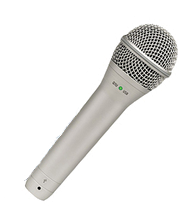
Check out the many articles and tutorials on home recording at www.HomeBrewAudio.com, where we show you how to let your need drive your recording gear acquisition as you progress. That should save you a boatload of money while getting you started out in audio recording quickly and easily. The term pro audio tools these days becomes more about knowledge and skill than about cost.
Give us a visit. We’ll see you around campus!
Ken
good recordings on a budget
How To Record A Voice Over With Audacity
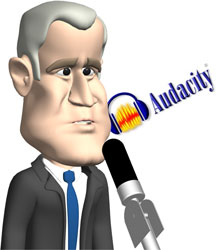 Here are some suggestions on how to record a voice over. Ready to land your next voice over job?
Here are some suggestions on how to record a voice over. Ready to land your next voice over job?
This is a fairly detailed step-by-step guide for creating a pro quality voice over using Audacity (the free audio software). The steps here will work for any mic, but you should use at least a decent USB mic like the Samson Q2U (which you can get for 59 dollarinis). Ready? Here we go.
1. Open Audacity (you can download that here)
2. Make sure your mic is set up in Audacity
To do that, go to Edit/Preferences/Devices (choose the Samson mic under “Recording” and make sure it says “mono” under “channels.”
3. Click the “Record” button (big red circle) in Audacity – a track will appear and begin recording.
4. Record your voice-over
Here are some tips for that:
- Use a pop filter if you have one. If you don’t, you can make one quickly by stretching an old pair of nylon stockings over a wire hanger that you have shaped into a circle. But you can buy one for about $10 on Amazon – Auray Pop Filter.
- Record in as quiet a place as possible.
- Keep you mouth close to the mic (3-5 inches). Most of us record in spare rooms in our house, which means lots of echo-y, reverb-y room sound. And one quick way to reduce that that you can implement immediately is simply to record close (that 3-5 inches I suggest) to the mic. I believe that this could be the most helpful bit of advice on how to record a voice over of everything in this post.
- Keep recording even in you make a mistake. I like to clap my hand or make some other quick, loud noise after a screw-up so that I’ll see it on the track when I’m editing. Just make that mark and continue recording. You can cut the bad takes out during editing.
- Make sure the wave forms (blue blobs) are fairly large in the track. You don’t want to over do it to where they go out to the edges and beyond. But if they are too quiet – not much more than what’s on the center line – then you should turn up the input level* and start again until you get fat and chunky blobs. This may be the 2nd most important piece of advice for how to record a voice over!
* If you are using an interface unit to plug your mic in, you can turn the input level up on that. If you have a USB mic, go into your Windows Sound control panel, click on the Recording tab, select your mic, select Properties, click the “Recording” tab, and then “Level.” Make sure the slider is at around the 85-90 percent mark. Sometimes Windows puts this level down to like 20% for some reason.
5. Hit the “Stop” button when you’re finished (big yellowish square).
6. Now find all the parts you want to cut out (bad takes, baby crying, phone ringing, etc.) by highlighting that bit of audio and simply hitting the “delete” button on your computer keyboard.
7. Once you’re left with the parts you want to keep, it’s time to reduce the ambient background noise.
8. Find a section of the recording where you’re NOT talking, but the mic was recording. Usually this will be low-level computer drive noise, electronic buzz or hum, etc.
9. Select Effect/Noise Removal in Audacity and select “Get Noise Profile.” The Noise Removal window will close. You’ve just told audacity what constitutes “noise.”
10. Select the entire audio recording (double-click on the audio), open the NR tool again, and click “OK.”
This will filter out the ambient noise and leave your voice alone (for the most part).
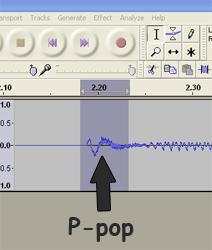
11. Listen carefully to the recording in headphones. You’ll likely have several “p-pops” or “plosives” as they are commonly called.
Zoom in to very beginning of an offensive p-pop (see:
https://www.homebrewaudio.com/how-to-fix-a-p-pop-in-your-audio-with-sound-editing-software for a bit more on this)
12. I find that bad p-pops tend to look like the letter “N” in the audio waveform.
See pic. Select just the “N” part and then go to Effect/Equalization in Audacity.
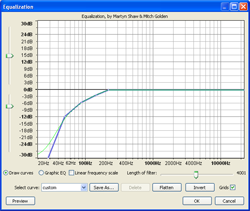
13. Create a curve on the horizontal line that starts sloping down to the left at about the 200-250 Hz spot.
Just click your mouse on the line wherever you want to create a drag-handle (4 or 5 spaced between 30Hz and 250Hz should do the trick). Then drag the 30Hz handle all the way down.
Drag the next one to the right down but not as far, etc. Continue until your curve looks like the picture above.
14. Then click “OK” and listen to the result.
The “p” sound should sound more natural and less like an explosion of air. You’ll also notice that the “N” shape is much smaller.
15. Next You’ll want to compress the audio just a smidge to even out the volume and give it some punch.
So select the entire audio file (double-click on the blue blob somewhere) and select Effect/Compressor. Set the sliders as follows: Threshold: -12 db, Noise Floor: -40 db, Ratio: 2:1, Attack Time: 0.2 secs, Decay Time: 1.secs.
Also, make sure there is a check in the box marked “Make-up Gain for 0dB after compressing.” Click “OK.”
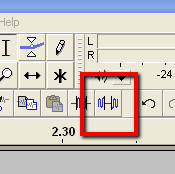
16. Now listen carefully, through headphones, to all the audio.
You may notice a few stray bits of unwanted noise in between the talking bits, so to fix those, just highlight them as you find them, and click the “Silence” tool button in Audacity (see Pic 3).
17. Lastly, save the audio in whatever format you need by selecting File/Export in audacity.
44.1KHz and 16-bit wav files are standard “CD quality” audio. Note that if you want to export the audio as mp3, you’ll need to download the Lame MP3 Encoder here: http://audacity.sourceforge.net/help/faq?s=install&item=lame-mp3 . That will install to the correct place automatically.
Hopefully that should give you an idea how to record a voice over, a professional sounding one, very quickly. For more in-depth info, check out our course, the Newbies Guide to Audio Recording Awesomeness.
Good luck.
Ken

Voice Over Recording While Camping–The Zoom H2 Saves My Butt
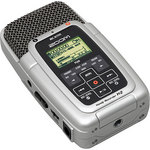 You’d think it would be a pretty good bet that I could take a week off without having to record any audio. After all, I’d had to actively submit auditions for all the voice over jobs I’d gotten at that point. So you might imagine my surprise when I got an e-mail on the 2nd day out (why was I checking e-mail? Brand new iPhone…but that’s a different story:)) I received an offer for a voice over job I hadn’t even auditioned for. And they couldn’t wait a week. It was take-it-or-leave-it. So I decided to give it a shot. Here is all the equipment I had with me.
You’d think it would be a pretty good bet that I could take a week off without having to record any audio. After all, I’d had to actively submit auditions for all the voice over jobs I’d gotten at that point. So you might imagine my surprise when I got an e-mail on the 2nd day out (why was I checking e-mail? Brand new iPhone…but that’s a different story:)) I received an offer for a voice over job I hadn’t even auditioned for. And they couldn’t wait a week. It was take-it-or-leave-it. So I decided to give it a shot. Here is all the equipment I had with me.If you’d like to get an idea of how the audio turned out, listen to the audio here:
[jwplayer config=”Custom Audio Player” mediaid=”3485″]
So now I know there is no reason to ever fear losing out on a recording gig when I’m on the go. All 3 required items fit very easily into a quite small hand bag or back pack.
Happy recording!
Ken
ps – By popular demand, here is an audio clip from the actual job – the final audio sent to the client.
[jwplayer config=”Custom Audio Player” mediaid=”11049″]
Voice Over Recording Using Audacity and a $49.00 USB Mic
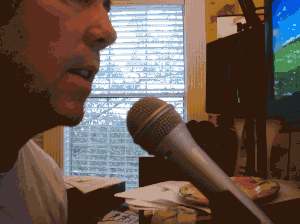 In order to demonstrate how professional sounding voice over recordings can be made (and in turn, voice over jobs be gotten) with very inexpensive home recording studios, I decided to do a quick demo. Take a listen to the below recording. It was recorded with a home studio that would cost you about as much as the USB mic I used, which is to say $49.00. Uh, huh. You heard right. If you already have a computer, you can set up a recording studio that can produce voice recordings like this for only about $49.00. I’ll say it one…more…time just for effect. You can start a home recording studio for $49.00!
In order to demonstrate how professional sounding voice over recordings can be made (and in turn, voice over jobs be gotten) with very inexpensive home recording studios, I decided to do a quick demo. Take a listen to the below recording. It was recorded with a home studio that would cost you about as much as the USB mic I used, which is to say $49.00. Uh, huh. You heard right. If you already have a computer, you can set up a recording studio that can produce voice recordings like this for only about $49.00. I’ll say it one…more…time just for effect. You can start a home recording studio for $49.00!
I recorded about a minute or so of an article I wrote to create this demonstration.
Recording Gear Used
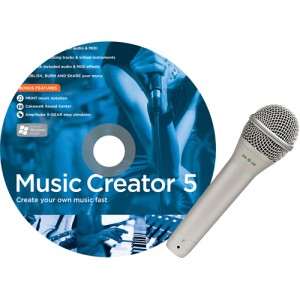
1. A run-of-the-mill Windows XP (Intel Core Duo, 3 GB RAM)
2. The Samson Q1U USB Microphone
3. Free recording software called Audacity
That was all I used. Here is how it came out:
[jwplayer config=”Custom Audio Player-200″ mediaid=”14417″]
The Step-By-Step
1. I plugged the USB mic into a USB port on my computer
2. I opened Audacity
3. I selected “Samson Q1U” as my recording device under “Edit/Preferences” in Audacity
4. I clicked the “Record” button in Audacity and spoke into the mic.
5. I performed the following edits on the recorded audio using Audacity FX tools:
a. Equalization and high-pass filter to reduce p-pops and other overly bass-y bits
b. Compression to even out the volume
c. Silencing and Cutting audio to cut out retakes and silent bits that were a little too long
d. Normalization to turn up overall volume to the point where the loudest bit of audio is JUST below 0 dB (the loudest that digital audio can be before distorting)
That was it. Then I just saved it as an mp3 and uploaded it.
If you’d like to get started learning to do this, check out our articles and video tutorials. Or you could snag The Newbies Guide To Audio Recording, our main tutorial course.

Better Audio On Your Videos With The Q3
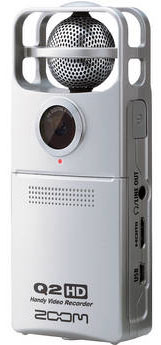 Most videos on YouTube have crappy audio. That’s because video cameras almost never have good quality microphones built in. But that’s all changed with the Zoom Q3 Handy Video Recorder note: this has been replaced by the Zoom Q2HD. It’s not only got a high-quality studio mic built in, it’s got two! They’re arranged at the top to give you excellent stereo sound to go with your video. This is an excellent piece of field or home recording gear. Of course, you can use it either as a video camera that has great audio, or as simply a hand-held digital audio recorder by switching modes and telling the Zoom not to record video – only audio. The Q3 (now Q2HD) is a very handy (ha ha, get it?) piece of recording equipment.
Most videos on YouTube have crappy audio. That’s because video cameras almost never have good quality microphones built in. But that’s all changed with the Zoom Q3 Handy Video Recorder note: this has been replaced by the Zoom Q2HD. It’s not only got a high-quality studio mic built in, it’s got two! They’re arranged at the top to give you excellent stereo sound to go with your video. This is an excellent piece of field or home recording gear. Of course, you can use it either as a video camera that has great audio, or as simply a hand-held digital audio recorder by switching modes and telling the Zoom not to record video – only audio. The Q3 (now Q2HD) is a very handy (ha ha, get it?) piece of recording equipment.
Just point and shoot, and when you finish with the high-quality stereo recording along with your video (or just the audio part if you don’t really need the video), plug it straight into your computer with the built-in USB cable. How’s that for awesome as well as convenient?
You should keep in mind on this, however, that if your are far away from the source, especially in a rectangular or otherwise “echo-y” room, the sound will still not be quite as good as if the Q2 is only a few feet away.
For more on how the quality of your audio is affected by how far away the source is on a video, see our post How To Get Good Audio On Your Videos, where you can hear examples of this in the video in that article.